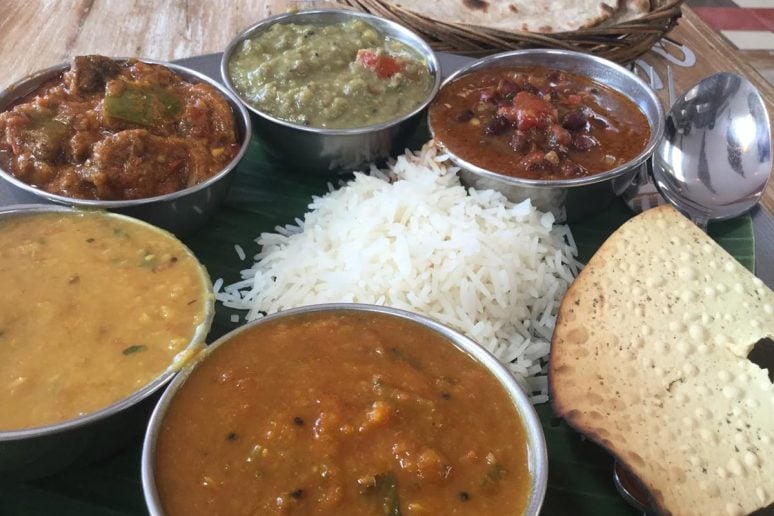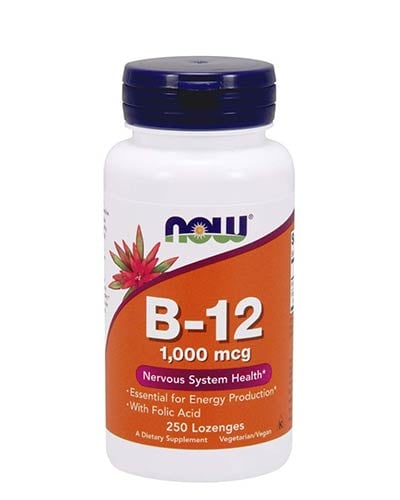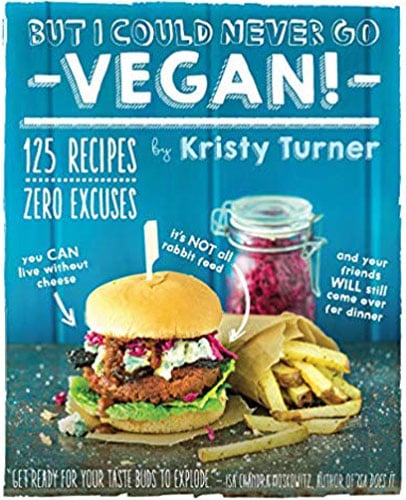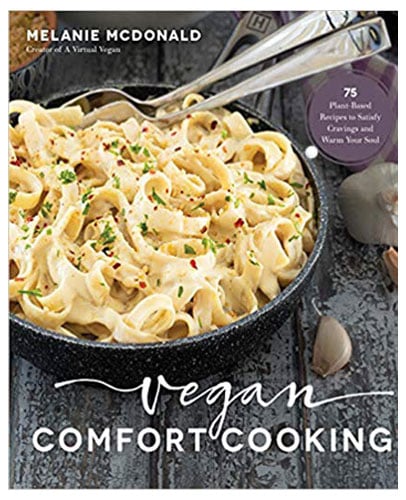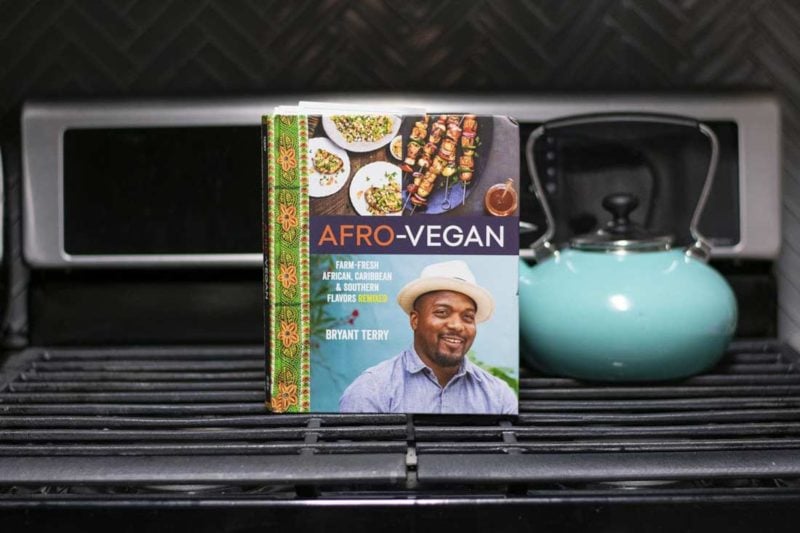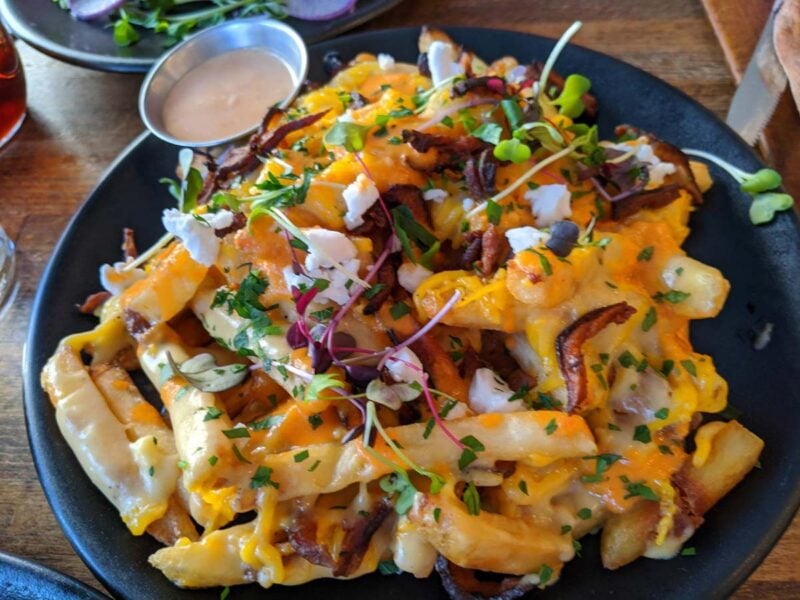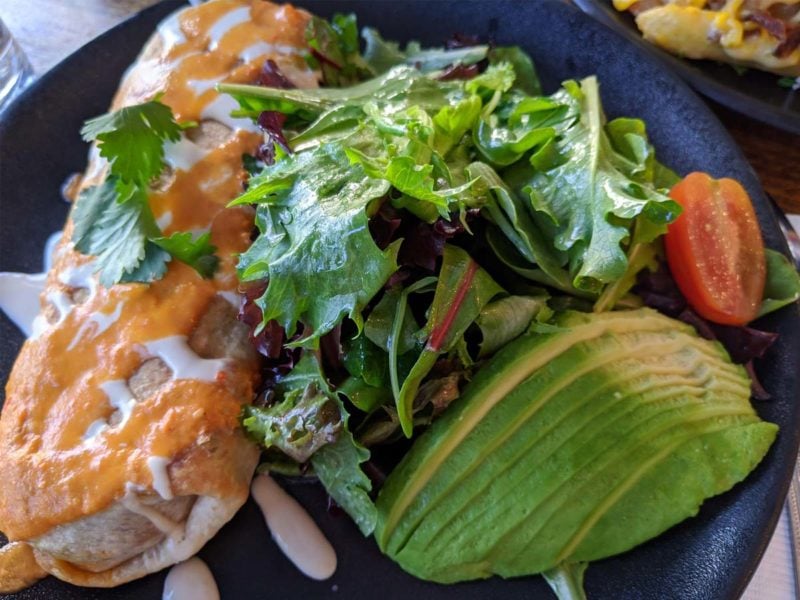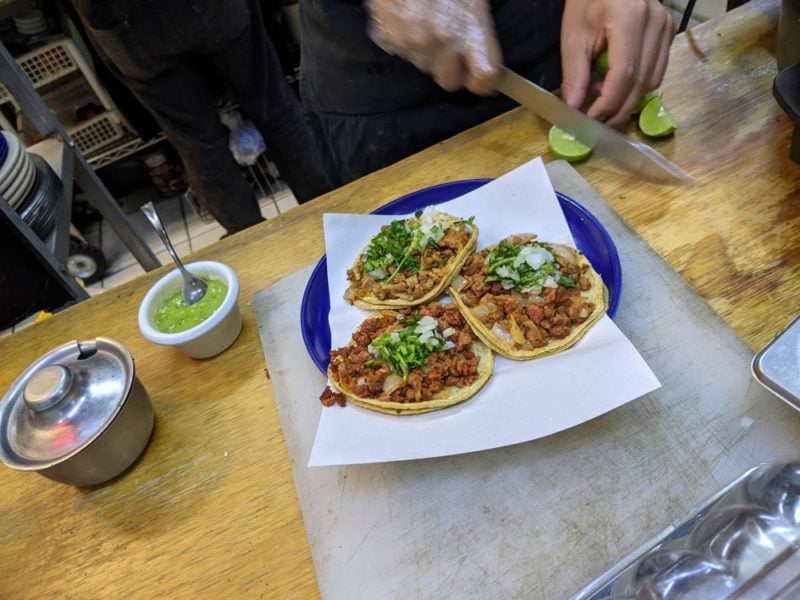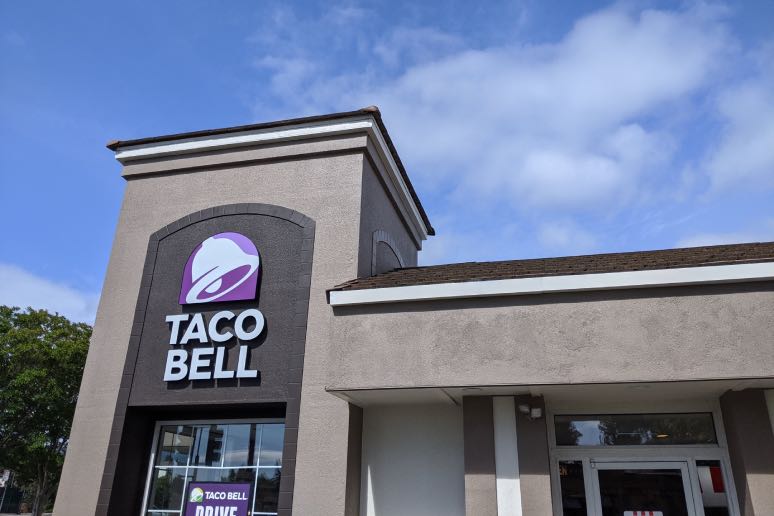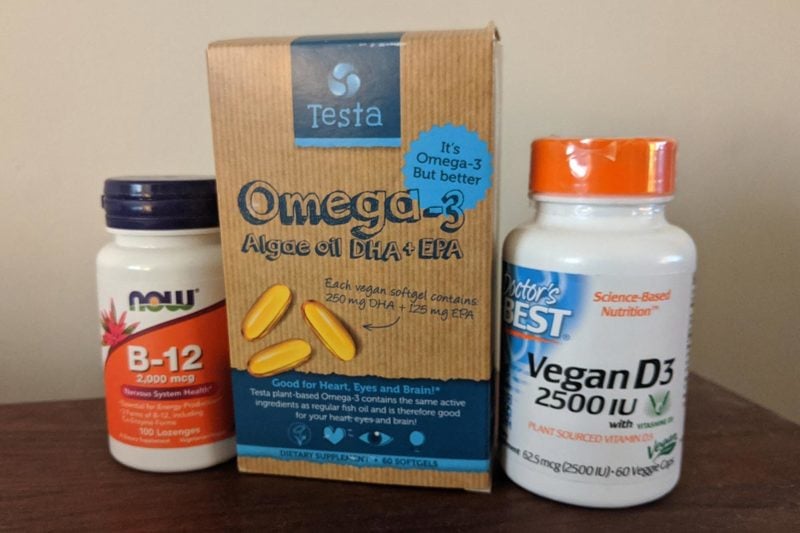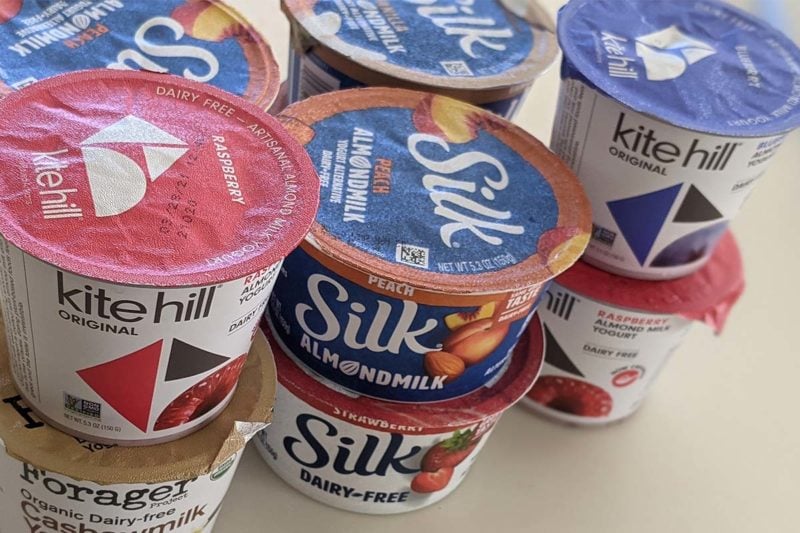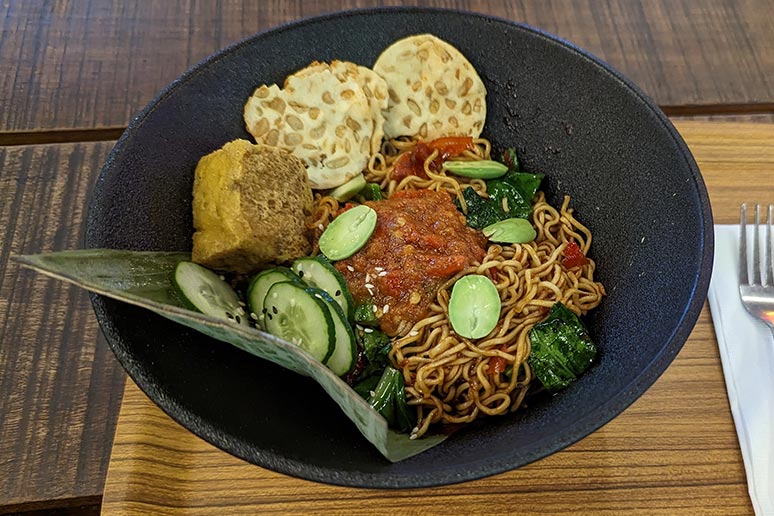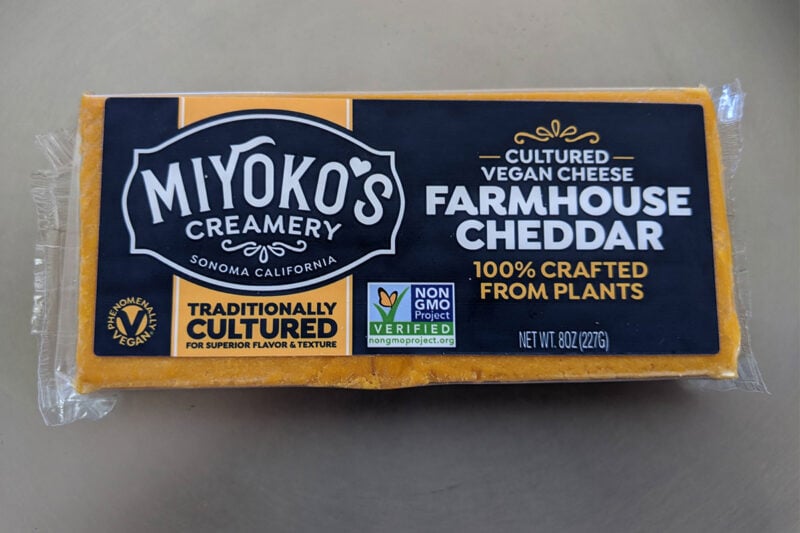Finding reliably vegan Indian food is tricky, which is a surprising situation for the world’s most vegetarian-friendly cuisine. But no worries—in this guide we’ll dive deep into Indian cooking to uncover some of the most delicious vegan foods you’ll ever taste.
Indian Food: One Country, Many Cuisines
When it comes to diversity, India is unmatched. No other nation features such a dizzying assortment of languages, religions, and cultures. What’s more, profound climate variations cause different foods to dominate each region. Every part of India has consequently evolved its own unique cuisine, based on its dominant cultures and whichever crops thrive locally.
My favorite vlogger, Mr. Bald and Bankrupt himself, put it wonderfully: “[India’s] cuisine changes from state to state, even sometimes from city to city. It’s such a varied country. They say In India, every 100 kilometers the food changes and the language changes.”
But no matter where you travel in India, vegetarianism is often the norm. For thousands of years, the pervasiveness of Hinduism, Buddhism, and Jainism caused most Indians to reject meat, fish, and eggs. No other part of the world has seen so many people eating so much vegetarian food for such a long time. So when it comes to offering up an endless assortment of vegetarian dishes, no cuisine compares to India’s.
We have a lot to cover here. So feel free to use the following links to skip ahead to the sections that particularly interest you. Following this brief introduction to India’s cuisine, I’ll introduce you to the country’s most prominent cooking ingredients, meals, and snacks. After that, I’ll offer advice on how to reliably order vegan meals served at Indian restaurants. Then I’ll try to talk you into visiting the Indian grocery nearest you by telling you about some must-purchase items. Finally, I’ll end with coverage of how to cook vegan Indian meals at home.
How Dairy Products Took Over Indian Cooking
No cuisine emphasizes dairy products more than Indian cooking. Dairy’s dominance arose partly from religious beliefs, and partly from nutritional concerns. Let’s now look at each of these factors.
Dairy Products and Hinduism
Widespread belief in karma and reincarnation helped establish vegetarianism as the default diet throughout much of India. Hindu scripture played a crucial role here by elevating the moral status of cows. Under Hinduism, cows occupy an exalted level of consciousness—a level even more rarified than that attained by ordinary people. To a devout Hindu, slaughtering cows therefore amounts to a sin with grave karmic repercussions.
Yet, simultaneously, Hinduism regards dairy products as a uniquely valuable food. Why? Primarily because, if cows indeed inhabit sublime realms of consciousness, it’s sensible to presume their milk confers unique benefits. Lord Krishna is famously associated with dairy products. One of the Vedas’ most famous passages recounts him, as a mischievous boy, stealing butter from the kitchen.
Many Indians today take the healthfulness of dairy as a matter of faith, and consider milk an indispensable food. They further assume that India’s cows enjoy a good quality of life (even though they generally don’t.)
Lest you think I’m exaggerating the importance that Hinduism assigns to dairy products, here’s what the Hare Krishnas have to say about the matter:
The teachings of Krishna consciousness emphasize the many transcendental benefits of milk. The Vedas say the cow is one of the mothers of mankind; cow’s milk and its many preparations are a key part of the recommended diet for human beings. Milk is considered essential for the proper development of the human brain, enhancing our ability to understand and apply spiritual knowledge.
These are some pretty strong claims that deserve some pushback and challenge. But no amount of evidence and debate is likely to knock dairy products off its pedestal when it comes to how many Indians think about nutrition.
Dairy Products and India’s History of Malnutrition & Famine
Dairy products became further entrenched in Indian cooking by virtue of their being a protein-rich alternative to meat. In a region long plagued by hunger, there’s no disputing that dairy products can provide valuable nutrients to people at risk of malnutrition.
Additionally, many Indians believe that dairy involves transmuting the blood of the cow into a purer, healthier substance that does not demand slaughter.
These factors caused dairy-based ingredients to become widespread in Indian cooking. Milk products appear everywhere and in every form. When eating at Indian restaurants, vegans must watch out for dishes containing milk, cheese, and yogurt sauces. Ghee (clarified butter) may appear in any sort of fried dish. Luckily for vegans, vegetable oil costs much less than ghee. Many Indian restaurants therefore don’t cook with ghee because of its added cost.
Although no other world cuisine leans so heavily on dairy products, it’s certainly possible to find terrific vegan Indian food. Later in this guide, we’ll look at how to avoid dairy products when dining at vegan restaurants. And of course, when cooking at home, you can easily remove the dairy products from any Indian recipe—especially since excellent vegan butter, sour cream, and cheese is widely available.
Essential Indian Cooking Ingredients
Let’s now look at some of the most common ingredients in Indian cooking.
Rice and Beans
Just as they do in Latin America, rice and beans provide the bulk of the calories in many Indian meals. But the varieties of rice and beans used in Indian cooking are different than those favored in Latin America.
Popular Rice Varieties
India is one of the world’s largest producers and consumers of rice, and many Indians eat it daily. The two most common varieties in India are white long grain rice, and a reddish whole grain rice. If you want to know why diabetes rates are off the charts in India, the habit of many Indians to eat white rice with practically every meal is surely a primary factor.
India is also famous for a fragrant long-grain rice variety called basmati, which is grown in the foothills in the northern part of the country. Basmati is nearly always milled into white rice. This is bad for nutrition, but convenient for home cooking, since the rice cooks in minutes. You can cook white basmati rice in a pot in barely about twelve minutes, compared to over 30 minutes for brown rice.
Basmati is among the most expensive rice varieties, and many Indians therefore eat it only on special occasions. India exports about half its basmati rice crop. Basmati happens to be the only variety of rice that I prefer white. I normally favor whole grain bread and brown rice, but I think brown basmati rice lacks the delicate texture of white basmati. Sure, white basmati is pure carbs, and contains no fiber or other nutrients, but it’s a delicious occasional treat.
When preparing basmati rice at home, drop a cardamom pod or some cardamom seeds into the water prior to cooking. Cardamom’s gentle flavor blends with basmati to produce one of the world’s great flavor combinations, right up there with chocolate and roasted peanuts.
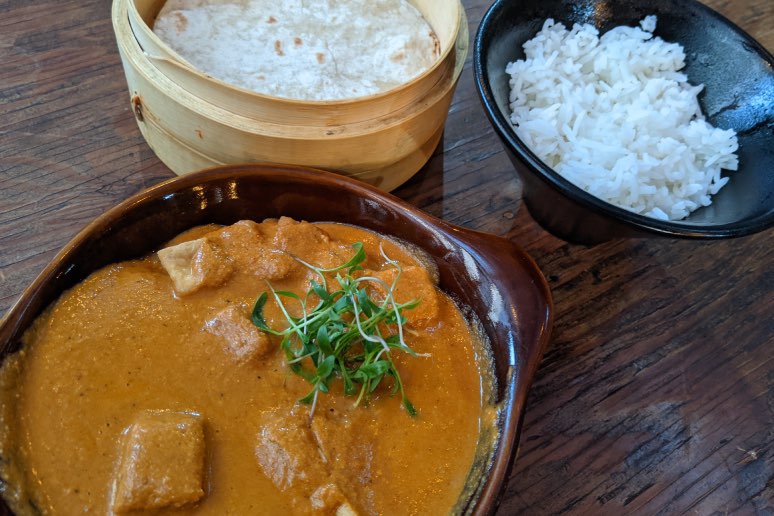
Beans
Beans are a crucial part of Indian cooking. They contain loads of protein and play an indispensable role in the country’s nutrition.
One of my Indian friends insists that, “Indian restaurants give a bad name to Indian cuisine.” By this, she means that many restaurants cook with only a tiny variety of foods. This is especially the case with beans, and most Indian restaurants use just four varieties:
- Lentils
- Split peas
- Chick peas
- Kidney beans
Of these beans, lentils and are probably the most important, since they’re used to make both soups and dosas (I’ll cover both these foods later on). Lentils come in several varieties, including black, brown, and red. Yellow split peas are also widely used for soup. Since lentils and split peas are so tiny, they cook much more quickly than larger varieties of beans.
Chick peas and kidney beans appear in a variety of curried stews. As beans go, chick peas and kidney beans are unusual since they both contain significant amounts of fat. This gives them a richer texture and flavor than other beans, most of which are practically fat-free.
Beyond Garbanzos & Kidney Beans
While Indian restaurants cook only a few types of beans, there are no such limitations for people cooking at home. Authentic Indian cooking features all sorts of obscure bean varieties. A serious Indian cook will have a dozen varieties of dried beans in their pantry. And any good Indian grocery will feature nearly an entire aisle devoted to different varieties of lentils.
Despite its immense popularity throughout most of Asia, tofu never became established in traditional Indian cooking. That’s a shame since this nutritious soybean product could have displaced a great deal of dairy foods, thereby improving the nutrient status of countless millions of people. While it’s certainly not a traditional ingredient of Indian cooking, sliced tofu works remarkably well in most spicy curry stews. So be open to adding tofu to your curries even if the recipe doesn’t call for it.
While traditional Indian meals don’t include tofu, textured vegetable protein is probably India’s most popular meat replacement. The stuff is cheap, filling, full of protein, and goes wonderfully in any sort of curried dish. One of the most popular such brands is Butler Soy Curls.
Popular Vegetables in Indian Cooking
Just as Indian restaurants use only a few types of beans, most are likewise surprisingly limited when it comes to vegetables. These are the most common:
- Potatoes
- Carrots
- Spinach
- Cauliflower
- Onions
- Green Peas
- Okra
- Eggplant
That’s a disappointingly slim assortment of vegetables. Luckily, both spinach and cauliflower are remarkably nutritious, and peas are loaded with protein.
In contrast to Indian restaurants, home chefs can make extensive use of vegetables. A nutritious dish based on leafy greens commonly makes up one course of any home-cooked Indian meal. No cuisine makes heavier use of fresh beans than does Indian food, and hard squash and gourds also appear in a wide assortment of dishes. Tomatoes are also remarkably common in Indian cooking, which is not surprising since tomato plants thrive in hot weather.
Many Indian cooks sprout mung beans and garbanzo beans. The sprouts are either cooked in curries or added fresh to salads.
Indian Spices
Spices are the foundation of Indian cooking. No other cuisine employs such a wide assortment of fragrant and colorful spices.
In order to wrap their heads around the unfamiliar flavors of this novel cuisine, British colonialists came up with the idea of assembling a spice mix they called “curry powder” to capture the most common spices of India. You can think of curry powder as the SparkNotes of Indian cooking—they give you the gist of a complicated book without actually having to read it. But eating a meal made with curry powder is to sacrifice authentic flavors for convenience.
Every supermarket stocks ground curry powder. If you are new to Indian cooking, curry powder offers a convenient way to jump in and produce meals offering India’s best-known flavors. You’ll save a lot of time over buying a bunch of spices separately and grinding them all up together. That said, serious chefs would cringe at the idea of purchasing curry powder. Not only does pre-ground curry powder suffer a loss of flavor, but by using this stuff you’ll forfeit your ability to adjust your dish’s seasonings to your taste. Instead of using packaged curry powder, Indian chefs mix together spices in the proportions they judge suitable for a given meal, then grind them on the spot.
Curry Powder
Serious Indian chef regard curry powder as training wheels for a novice cook. Its primary components are:
- Cumin
- Coriander
- Turmeric
- Cayenne Chili Pepper
- Fennel
- Mustard
- Pepper
Of these spices, turmeric deserves a special mention. It’s bright yellow, and has a bitter and not enjoyable flavor on its own. But it somehow meshes perfectly with other Indian spices. Most westerners buy it in powdered form, but if you’re lucky, you’ll be able to find fresh turmeric roots at your grocery. They look like miniature orange ginger roots. Just like ginger, you can skin and mince fresh turmeric and then mix it in with your other seasonings.
Other common curry spice ingredients are cinnamon, cloves, cardamom, chili powder, and minced or powdered ginger. Garlic and onions are also ubiquitous in Indian food.
Garam Masala
Along with curry powder, another popular pre-mixed Indian spice is called garam masala. Although garam means hot in Hindi, this does not denote the hot spiciness of chili peppers, but rather a quality that warms the body (this relates to ayurvedic health theories, which I’ll briefly cover later on). The only spicy-hot component of garam masala is a tiny amount of black pepper. Most of its other ingredients are sweet rather than hot, and include, cinnamon, cardamom, bay leaf, star anise, and nutmeg. As with curry powder, every chef will choose a slightly different assortment of spices when preparing garam masala from scratch.
For both curry powder and garam masala, the spices are toasted together in a dry skillet, and then ground up into powder. Ideally, you’ll heat and grind your spices fresh for each meal.
North and South Indian Food
As we dig deeper into Indian cooking, it’s useful to distinguish between the foods cooked in North India and South India. These regions feature completely different dishes, but they do share similar flavors since all rely on classic Indian spices. Broadly speaking, since Northern India has more cows, its cuisine relies more heavily on dairy products. But that does not make South Indian cooking dairy-free by any means, although it is comparatively unusual to find paneer (Indian cheese) in dishes native to the South.
Vegetarian restaurants throughout India often use confusing term to classify their food. Thousands and thousands of Indian restaurants feature the words “Pure Veg” on their storefront signs. While “Pure Veg” certainly sounds vegan-friendly, it simply means they never cook meat. Many of these restaurants put dairy in practically everything.
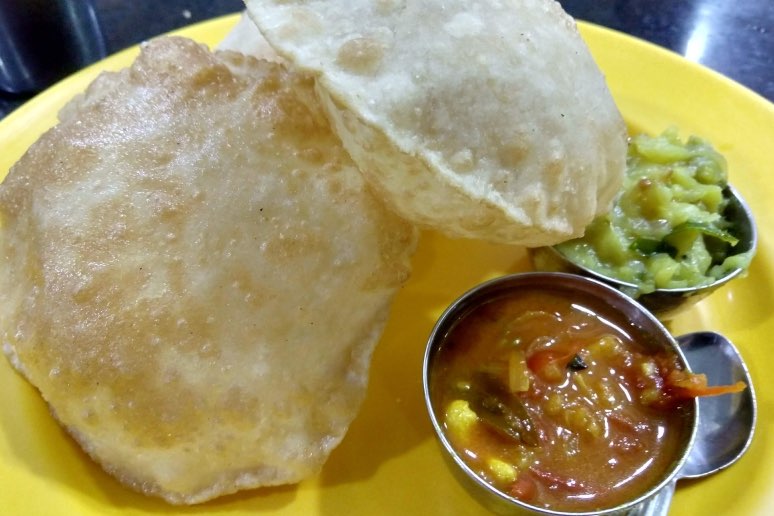
Indian Snacks & Appetizers (Chaat)
We could endlessly debate over which of the world’s cuisines offers the most magnificent meals. The French, the Italians, the Vietnamese, and many other cultures can all lay strong claims to this honor. But there’s no doubt—none whatsoever—about who has the best snacks. It’s Indian cuisine, hands down. Honestly, I’d rather eat a few Indian snack items than an Indian dinner, and I love Indian dinners!
The Hindi word for snack is chaat, and Indian “chaat houses” are everywhere—not just in India but in virtually every city with a good-sized Indian community. Worldwide, there are thousands of chaat houses that serve nothing but snacks.
There’s no clear dividing line between chaat and Indian appetizers, but one clear giveaway is that food carts serve nothing but chaat. It’s India’s quintessential street food. Nearly all varieties of chaat are accompanied by yogurt, tamarind sauce, chopped cilantro, some sort of masala seasoning, or chutney. Since yogurt is a standard garnish, you should always request no yogurt when ordering. If you’re making chaat at home, or ordering it delivered, unsweetened vegan yogurt makes an excellent replacement for dairy yogurt.
Puris and Bhature
Centuries before the State Fair of Texas came into existence, Indians were eating deep fried bread. Puris are the most common variety—made from deep fried whole wheat dough and served with chutney.
A similar but exceedingly eye-catching dish is chole bhature, which looks like ordinary puri but is several times larger. My favorite chaat house aptly describes chole bhature as, “the big puffy thing.” It’s a deep fried flat bread that inflates like a balloon during frying. You tear off pieces and dip them into whatever spicy chutney accompanies your order.
Other than size, the main difference between puri and bhature is that the latter usually contains white rather than whole grain flour. Both puri and bhature dough commonly contain curds or yogurt, so vegans must always inquire before ordering.
Samosas & Pakora
Two other popular deep fried chaat items are samosas and pakoras. Samosas are triangular vegetable-stuffed pastries, either served with chutney, or dunked into a spicy chickpea curry. Pakoras are bite-sized pieces of vegetables dipped into a spicy chickpea flour batter and deep fried. While samosas sometimes contain meat, a vegetarian samosa is reliably vegan. And pakoras are always vegan.
Aloo Tiki
Although not as well-known as samosas or pakora, aloo tiki is my favorite chaat item. They’re fried potato dumplings, wonderfully spiced and topped with a savory sauce. They’re commonly garnished with yogurt, which vegans should ask to omit.
Vadas
You’ll know vadas when you see them, since they’re the size and shape of donuts. Vadas use a savory bean-based batter, which makes them insanely filling. They are served straight from the deep-fryer, with a squirt of tangy chutney. Despite their undeniable status as an indulgent deep-fried snack, the bean-based batter makes vadas a rich source of protein and other nutrients.
****
There are dozens of other different chaat items, so this brief coverage can’t begin to do justice to all the possibilities. But I do hope what I’ve written here inspires you to seek out your nearest chaat house.
Admittedly, on your first visit you may feel overwhelmed by all the unfamiliar offerings. I suggest you hang out at the counter for a while before ordering, so you can see what other customers are getting. When you spy something coming out of the kitchen that looks especially appealing, inquire about its name and its vegan status.
Classic Indian Meals
Now that we’ve covered Indian snacks, let’s take a look at the most common vegan-friendly Indian meals.
Curries
The most well-known sorts of Indian food are the curried stews of Northern India. These stews are made from beans or vegetables, and are usually served over rice, or served alongside idlis (which I’ll cover in a moment).
Aloo gobi—potatoes and cauliflower, seasoned with cilantro and onions—is one of the most popular Indian stews. Equally popular is chana masala—chickpeas in a spicy curried sauce. Your Hindi vocabulary lessons here are:
- aloo = potato
- gobi = cauliflower
- chana = chickpeas
- masala = spice
Saag Paneer
Perhaps the most nutritious of all popular Indian entrees is Saag Paneer. Since Saag means spinach and paneer means cheese, this dish, when prepared traditionally, is never vegan. On top of the cheese, this dish often contains cream.
But when cooking at home you can replace the cheese with firm tofu or your favorite hard vegan cheese. A bit of cashew cream or other unsweetened vegan milk will substitute nicely for cream. When spiced correctly, it’s such a flavorful dish that you can do away with the dairy products entirely with no discernible loss.
Think of saag paneer as creamed spinach with Indian spices and a fair bit of oil. Since many Indian dishes lack appreciable amounts of vegetables, saag paneer is a great dish to pick up the slack. It’s fantastic with flat bread or served over basmati rice.
Dal
Dal is by far India’s most popular soup. Many Indians eat it daily. Dal’s main ingredient is either cooked lentil beans or yellow split peas. These pulses are pureed into a thick and satisfying soup. Dal has loads of flavor since it contains curry spices, fresh ginger, onions, or slivered garlic.
Dal accompanies many Indian meals. It’s either served in a bowl and eaten as a soup, or it’s poured over rice. Its lentils or split peas put dal among India’s most protein-rich dishes.
Dosas
Dosas are crepes, often larger in diameter than a dinner plate, that are a mainstay of South Indian cooking. The primary ingredient is a lentil batter that’s fermented for a couple days at room temperature. This fermentation gives the dosas a tangy flavor. Regular dosas are made from rice and lentils, whereas rava dosas are made from wheat and lentils.
Dosas are folded around a savory filling, most often spiced potatoes and onions. Many South Indian restaurants offer at least ten varieties of dosa, each with different fillings and spices. If you like strong seasonings, order a masala dosa.
Biryani
This dish arrived in India via Muslims from the Middle East and elsewhere. Biryani is a bright yellow rice dish similar to Asian fried rice and Spanish paella, but with different seasonings. The Hindu populations emphasized the addition of vegetables, whereas other parts of India added fish and meat. The dominant spices of biryani are cinnamon, star anise, and mace—which together impart a very different flavor than that offered by any other Indian-style dish.
Owing to the fact that its primary ingredient is expensive basmati rice, many Indians reserve biryani for special occasions. Since it’s ideally suited to preparation in large batches, biryani is one of India’s most popular wedding foods. While it may be tough to find vegan biryani when eating out, this is an easy dish to cook vegan at home, and its unique flavors make it a must-try Indian meal.
Kitchari
Kitchari is a widely-consumed but not widely-beloved Indian meal. Yet again, a quick Hindi lesson comes in handy. The word kitchari simply means “mixture,” and when applied to this dish it refers to a mixture of rice and split yellow peas. If that doesn’t sound all that appetizing, you’re correct.
If you visit an ashram in India, it’s likely that they will serve you kitchari as one of your daily meals. That’s because most ashram food strives to be blandly wholesome. You go to an ashram primarily to loosen your attachments to sensory gratification, and nothing washes away your lust for enticing flavors (or exacerbates these lusts!) like a string of boring meals. Kitchari is India’s least tantalizing food, but it’s light on the stomach and digests easily.
Kitchari is one of the key foods within the ayurvedic tradition. Ayurveda is an ancient Indian approach to health that is largely based on consuming foods and spices chosen to correct bodily imbalances. Kitchari accommodates a wide assortment of spices, with each spice associated with different health properties. When prepared in the ayurvedic tradition, kitchari is spiced to remedy a person’s particular imbalances and maladies. When ill, many Indians eat mostly kitchari in hopes that this food will restore their health.
The best thing about kitchari is that, unlike most vegetarian Indian meals, the stuff is nearly always vegan by default.
Side Dishes (Idlis, Flatbreads, and Rice)
When dining at Indian restaurants, your waiter will protest if you attempt to order a curried dish or a soup on its own. These dishes are invariably accompanied by idlis, flatbread or rice.
Idlis
Idlis (pronounced: id-lee) are one of the most popular foods in India. They’re oblong balls or disks made from steamed ground-up white rice and urad dal (white lentils with the black husk removed). Idlis range from about the size a peach pit to as big as your palm.
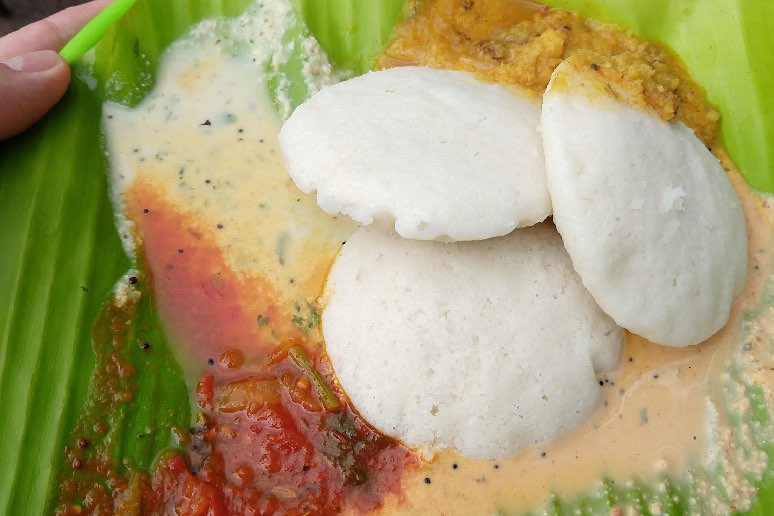
Idlis have little flavor. They exist as a bland base intended to soak up and counterbalance spicy Indian soups and sauces. Indians often order idlis instead of basmati rice, and mash them into their curried stews—this is quite similar to mashed potatoes and gravy, albeit with different starches and proteins. Alternately, they’ll tear off a portion of idli, and dip it into sambar, a delicious and extremely spicy reddish spicy soup. Indian restaurant menus often list idli sambar as a single menu item.
Flatbreads
Flatbreads accompany a great many meals in India. As with Ethiopian food, you’ll often use flatbread rather than utensils to eat your meal. Typically, you tear off a small piece, and use it to grab a fork-sized portion of whatever curried stew you’re eating. As an aside, this is why most Indians are in the habit of washing their hands right before eating—many restaurants in India even have a hand-washing sink in the main dining area.
The two most common varieties of flatbread are roti and chapati, the former rolled flat with a rolling pin and the latter patted flat by hand just like a homemade Mexican corn tortilla. Both these breads feature whole-grain flour, so they’re quite nutritious. It’s hard to know what you’ll get when you order flatbread since there’s so much variation in thickness and cooking styles. Neither roti nor chapati dough commonly contains dairy products, but these breads are often garnished with some butter or ghee after cooking.
Another common flatbread is called naan, which is not only less healthful than roti or chapati, it’s also rarely vegan. It’s usually made of white flour, and the dough often contains milk. Naan is Iranian in origin, and similar to the lavash bread served in the Middle East. Even though it’s not terribly healthy, vegan naan is worth seeking out. Authentic naan is cooked in a tandoor (a clay oven), which imparts a sensational texture. Unfortunately, you should assume naan contains milk unless the waiter or ingredient label tells you otherwise.
When eating out, vegans should avoid naan and request either roti or chapati served without butter or ghee.
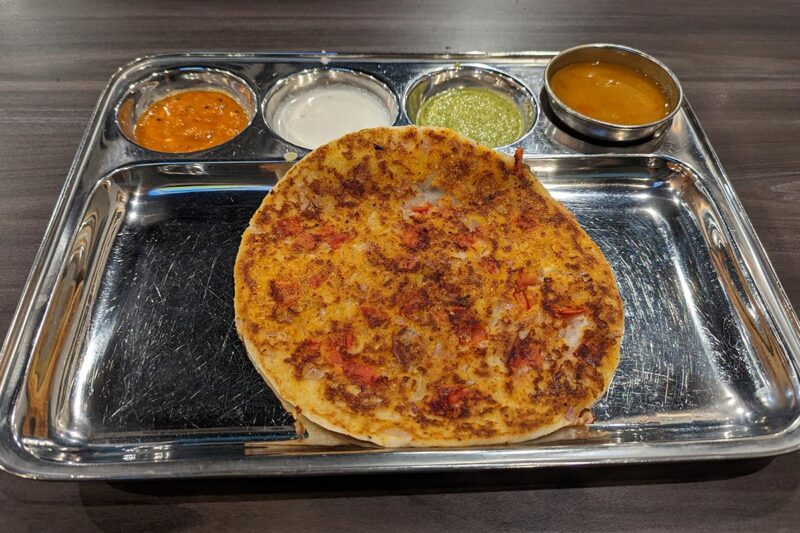
Rices
Indian restaurants commonly serve small bowls of steamed plain white rice to accompany their meals. Fancy restaurants will offer basmati rice.
Indian Desserts
We’ve just witnessed the abundance of excellent vegan meal and snack possibilities that Indian food offers. Sadly, I have only bad news when it comes to desserts. One of my vegan Indian friends says dismissively: “There’s nothing to eat.”
Nearly every popular Indian dessert contains dairy products or honey. If you’re lucky, you might be able to find vegan kaju burfi or jalebi, but even these dishes usually contain milk products.
So if you want a vegan Indian-style dessert, you’re probably either going to have to make it yourself or dine at a vegan Indian restaurant. Luckily, you won’t have any trouble finding suitable recipes. Vegan Richa’s Indian Kitchen features veganized versions of eighteen traditional Indian desserts. Sahara Rose Ketabi’s Eat Feel Fresh likewise includes an extensive Indian dessert selection.
Ordering Vegan Indian Food from Restaurants
When dining at Indian restaurants, your main job as a vegan—really, your only job—is to avoid hidden dairy products. The presence of meat is obvious in Indian dishes. And Indian cooking never evolved to include eggs. So, as long as you can determine that your Indian meal is dairy-free, you’ll know it’s vegan.
This plays in stark contrast to cuisines like Mexican food, which feature a wide assortment of animal ingredients. Mexican food forces vegans to contend with lard, chicken stock, and sour cream—all of which commonly evade detection.
That said, it’s likewise difficult to determine whether a given Indian dish contains dairy products. You’ll often have a tough time knowing for sure because milk products are generally used in small quantities in meals dominated by brightly-colored seasonings and spicy flavors. Without a menu clearly designating vegan offerings, you can be in trouble. In many Indian restaurants, the waitstaff won’t know the vegan status of their food, and language differences can complicate communication.
Dairy Products are Everywhere
To improve your chances of getting a vegan meal, consider ordering papadums rather than flat bread, and ask that they not be brushed with butter prior to serving. Papadums (sometimes nicknamed “poppers”) are super thin wafers of lentil flour and spices that, when cooked, bubble up with blisters and have a satisfying crunch. Restaurants usually prepare papadums by either dipping them into oil or heating them over a flame.
Soups are another hazardous choice for vegans in most Indian restaurants. Dal—by far the most popular Indian soup—is made primarily from lentils and spices. Unfortunately, the spice combination (called tadka) that goes into dal is commonly sauteed in ghee. Since restaurants prepare dal by the kettle, it won’t be possible to order yours vegan if its tadka contains ghee. Some restaurants may use vegetable oil to fry the tadka, either to please vegans or to save money on ingredients.
In addition to ghee, the other common words to watch out for on Indian menus are paneer (cheese) and dahi (yogurt).
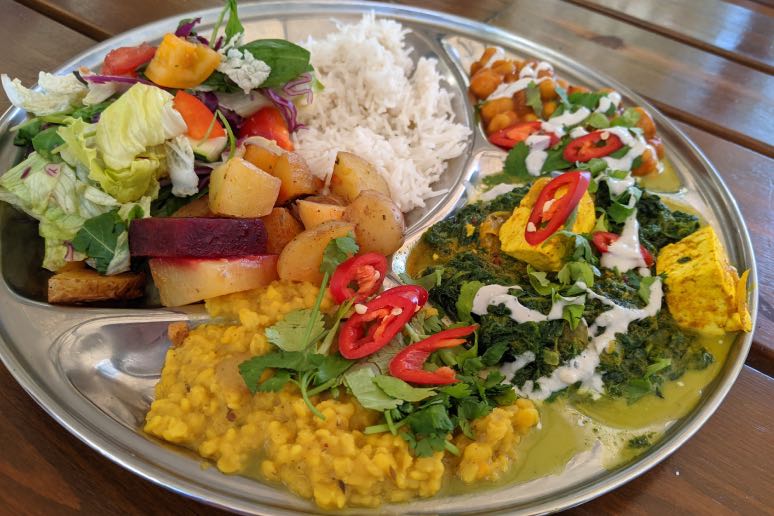
Indian Menu Items that are Consistently Vegan
At some Indian restaurants, you may find it nearly impossible to ascertain the vegan status of a particular dish. Often, your waiter won’t have a clue, or you may struggle to clearly communicate. I’ve lost count of the number of times this has happened to me.
So where does all this leave us? There’s never any guarantee, but here are some popular and reliably vegan Indian restaurant foods:
- Chana masala
- Kitchari
- Dosas
- Pakoras and Vegetable Samosas (as appetizers)
- Basmati Rice
- Idlis
- Roti and Chapati (but avoid ghee chapatis, which contain milk, and ask that they be served without butter)
You’ll of course have much more extensive options at restaurants that strive to accommodate vegans. But it’s comforting to know that even at the most mainstream Indian restaurants, the above choices are sufficient to guarantee you a satisfying and reliably-vegan meal.
Finally, keep in mind that many non-Indian vegan restaurants have Indian options on the menu. In my experience, Indian food usually turns out pretty good at places that don’t specialize in the cuisine, even if the flavors aren’t perfectly authentic. This is in stark contrast to Middle Eastern food, which is generally wretched at restaurants that also cook other cuisines.
Buying Vegan Foods at Indian Grocery Stores
Nearly every city with a sizable Indian population has at least one Indian grocery. These stores are well worth seeking out, as they’ll stock delicious vegan foods you can’t find elsewhere. Better yet, they usually have excellent prices on many popular vegan items.
If you get a chance to visit an Indian grocery, five items in particular—all imported from India—are worth stocking up on:
- Mango pickle (and other glass-jarred pickle condiments). Just a teaspoon or two served as a garnish alongside your favorite curry will add another dimension to your meal. Many Indian groceries carry nearly a full aisle’s worth of these condiments, so bring home a new variety every time you shop.
- Papadums. These are the paper-thin lentil wafers that I mentioned earlier. They’re a quick, spicy, protein-rich snack. Each papadum costs only a few pennies, and they’re great at staving off hunger if you’re not ready for a meal. They also make a terrific accompaniment to Indian take out food, or whatever Indian meal you’re cooking at home. They’re traditionally deep fried, but are also delicious when cooked over a flame. Or, for instant preparation, just heat them in a microwave for about fifteen seconds apiece until they uniformly blister. Although microwaved papadums won’t develop the delicious char created by flame-cooking, they’re still quite tasty and no snack is quicker to prepare.
- Foil-packed entrees. All these products come in a foil pack inside a cardboard box. Tasty Bite is the most popular brand, and most of the other brands are surprisingly good. The best of these products are comparable to decent Indian take-out food. Although many of these offerings contain dairy, most brands offer a vegan chickpea or kidney bean curries. If you don’t have an Indian grocery in your community, you can also order these products from Amazon. For a cheap meal that could pass for home-cooked, these products are impossible to beat. I especially recommend Tasty Bite’s Channa Masala.
- Lotus seeds. You pop these just like popcorn, with some oil in a covered frying pan. Season with chili powder, turmeric, curry leaves, and salt.
- Tamarind sauce. The perfect accompaniment to samosas and other chaat items. Tamarind paste or sauce should contain only a few ingredients—avoid brands with preservatives and colorants.
The above items are only the start of your options. Indian groceries also offer great deals on basmati rice and a multitude of dried beans. And if you check the freezer case, you’ll no doubt find some appealing frozen vegan convenience foods.
If I still haven’t persuaded you to make a special trip to your nearest Indian grocery, perhaps this next tip will do the trick: most of these groceries sell fresh, locally-made vegan samosas and pakoras. They arrive fresh each day and are kept warm under heat lamps. Invariably, these items are unbelievably cheap, yet deliver flavors you just can’t get from packaged food items. You can make a simple vegan meal at home, then serve it with some Indian grocery samosas and some mango pickle, and suddenly you have a borderline feast.
Also seek out the grocery’s clamshell-packed prepared foods. These too are locally made, and include everything from dried spicy peas to desserts. Keep a special eye out for dhoklas—savory bright yellow cakes made from a batter of fermented chickpeas and rice. Dhoklas are India’s counterpart to Mexican corn bread, but their chickpea flour provides greatly superior nutrition.
Cooking Vegan Indian Food at Home
By doing your own cooking, you’ll be able to create an endless variety of vegan Indian dishes. No cuisine offers more extensive vegan possibilities.
The best way to eat reliably vegan Indian food is to make it yourself. Since you’re in control of your ingredients, this is a surefire way to guarantee that your meal will be absolutely, positively vegan. I usually advise people to cook only from vegan cookbooks, but Indian food tends to be much more easily veganized than other cuisines. It’s usually just a matter of using vegetable oil instead of butter and unsweetened soy yogurt in place of dairy yogurt. The results never suffer from these easy swaps.
Start with the simple stuff. Dal is by far the easiest Indian food to make. After that, move into to North Indian stews served over basmati rice, and perhaps some flatbreads or pakoras. Fresh chutneys are nearly effortless to prepare if you can get ahold of fresh mangoes or tomatoes.
South Indian foods often require special expertise and equipment. In particular, foods like dosas and chole bhature are way out of reach for the casual non-Indian cook.
If you’re planning to cook Indian food at home and you have an Indian grocery nearby, definitely head over there to lay in some supplies. Don’t forget to pick up some samosas or pakoras as an appetizer, plus a jar of mango or lime pickle to garnish your meal.
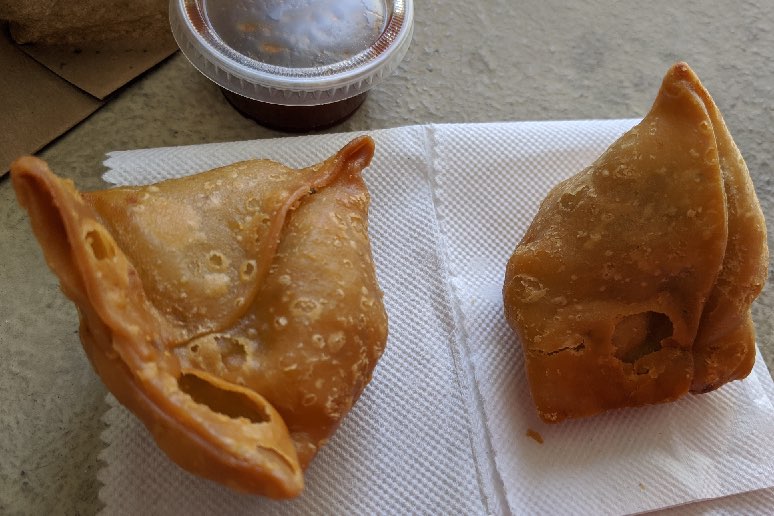
Vegan Indian Cookbooks
There are several excellent vegan Indian cookbooks available:
- The Essential Vegan Indian Cookbook, by Priya Lakshminarayan
- Vegan Richa’s Indian Kitchen, by Richa Hingle
- Instant Pot Vegan Indian Cookbook, by Meena Agarwal
- Heavenly Vegan Dals & Curries, by Rakhee Yadav
- Veganbell’s Indian Vegan Cookbook, by Pokhrel & Niroula
- Vegan Indian Cooking, by Anupy Singla
All of these are impressively comprehensive books crammed with beautiful color photography. They feature extensive introductory text that will acquaint you with the most common spices, ingredients, and cooking methods of Indian cuisine.
Let Vegan Indian Food Into Your Life
Indian food—especially the type served in restaurants—may not be the world’s healthiest cuisine, but what it lacks in nutrition it more than makes up for in flavor. Some of the most delicious vegan dishes you’ll ever try come from India.
No matter where you live, you can probably find vegan Indian food locally. Sure, dining at Indian restaurants can pose challenges. But as long as you steer clear of hidden dairy products, you’ll find an unrivaled assortment of vegan possibilities. With just a little effort you can discover some incredible meals. In cases where navigating the menu proves tricky, order the pakoras or a vegetable samosa as an appetizer, and then the chickpea curry (chana masala) with basmati rice for your entree. These items rarely contain dairy, and almost every Indian restaurant has them on the menu.
When you’re cooking at home, and therefore in total control of the ingredients, your vegan options are unlimited. Vegan Richa’s Indian Kitchen is a superb cookbook that will teach you to make all the classic North and South Indian dishes. Many delicious curries are ideal for beginner cooks, and Indian cuisine also features numerous extravagant gourmet recipes. So if you want to discover astounding vegan dishes, put Indian food among the first cuisines you explore.
For further reading: Check out our Vegan Cooking Guide as well as our links to the best vegan cuisines.
I am indebted to my friends Anita Krishnan and Sonu Lamba for helping me get a better grasp of Indian cooking, and for correcting innumerable errors in early drafts of this article.

